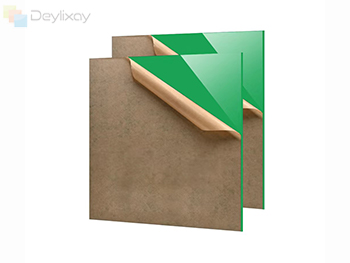Bežný zmätok vzniká v dielňach, umeleckých štúdiách a obchodoch pre domácich majstrov, keď sa používajú výrazy „Akryl“ a „plexisklo“. Otázka, či predstavujú rôzne materiály alebo sú v podstate totožné, je zásadná pre každého, kto zvažuje ich použitie v projekte. Priama odpoveď je, že vo veľkej väčšine prípadov sa týkajú rovnakej základnej látky. Vzťah medzi nimi je však najlepšie opísať ako vzťah kategórie k značke, podobne ako rozdiel medzi vreckovkou na tvár a Kleenexom alebo medzi vysávačom a vysávačom Hoover. Pochopenie tohto jemného rozdielu je kľúčom k prijímaniu informovaných nákupných rozhodnutí a pochopeniu širšieho prostredia plastových fólií. Akryl je všeobecný chemický názov pre všestranný typ plastu, ktorý je vedecky známy ako polymetylmetakrylát (PMMA), syntetický polymér známy svojou čírosťou, pevnosťou a odolnosťou voči poveternostným vplyvom. Na druhej strane, plexisklo je jednou z historicky najvýznamnejších a najuznávanejších značiek, pod ktorými sa akrylové dosky predávajú, pričom sa stalo tak rozšíreným, že sa často používa ako všeobecný termín pre akúkoľvek priehľadnú plastovú fóliu, bez ohľadu na jejskutočné zloženie.

Pôvod značky Plexiglas sa datuje do 30. rokov 20. storočia, ktorú vyvinula chemická spoločnosť Röhm & Haas. Bola to jedna z prvých komerčne úspešných a široko dostupných foriem liatych akrylových dosiek uvedených na trh. Jeho počiatočné aplikácie boli revolučné a našli kritické využitie v krytoch vojenských lietadiel počas druhej svetovej vojny vďaka svojej výnimočnej čírosti a vlastnostiam odolným voči rozbitiu v porovnaní so sklom. Toto skoré prijatie upevnilo jeho povesť kvality a odolnosti. Keď sa patent na materiálový proces stal dostupnejším a do arény vstúpili ďalší výrobcovia, začali vyrábať vlastné verzie PMMA dosiek. Títo konkurenti zaviedli svoje vlastné značky, ako napríklad Lucite, Perspex a Acrylite, aby odlíšili svoje produkty na trhu. Preto, keď sa spotrebiteľ pýta na plexisklo, často špecificky požaduje produkt od originálnej značky alebo, častejšie, používa tento výraz všeobecne na označenie akejkoľvek vysokokvalitnej akrylovej dosky. Keď žiadajú akryl, majú na mysli celú kategóriu materiálov, ktorá zahŕňa všetky tieto značky vrátane plexiskla.
Tento rozdiel medzi značkou a materiálom, aj keď je zdanlivo jednoduchý, má praktické dôsledky. Nie všetky akrylové dosky sa vyrábajú podľa presne rovnakých noriem alebo pomocou rovnakých procesov. Dva primárne spôsoby výroby akrylovej fólie sú odlievanie buniek a kontinuálne odlievanie, často označované ako extrudovanie. Liaty akrylát, ktorý je typom historicky spojeným so značkou plexiskla, sa zvyčajne považuje za prémiový produkt. Vyrába sa naliatím tekutého monoméru MMA do formy medzi dve tabule skla, kde sa potom zahrieva a vytvrdzuje. Výsledkom tohto procesu je list, ktorý má vynikajúcu optickú čistotu, vyššiu molekulovú hmotnosť, väčšiu chemickú odolnosť a je vhodnejší pre zložité výrobné techniky, ako je tepelné tvarovanie, pretože je menej náchylný na praskanie pri namáhaní pri zahrievaní alebo rezaní. Je tiež dostupnejší v širšej škále farieb a špeciálnych efektov. Extrudovaný akrylát, vyrábaný mnohými výrobcami vrátane tých, ktorí vyrábajú generické listy, sa vytvára tlačením zahriatej akrylovej hmoty cez sériu valcov, aby sa vytvoril súvislý list. Táto metóda je nákladovo efektívnejšia a efektívnejšia, čo vedie k všeobecne nižšej cene. Extrudovaný akrylát má tendenciu mať vynikajúcu konzistenciu v hrúbke, ale môže byť mäkší a náchylnejší na poškriabanie a chemické poškodenie.
Pre priemerného používateľa môžu byť výkonnostné rozdiely medzi značkovým liatym akrylátom, ako je plexisklo, a generickým extrudovaným akrylátom zanedbateľné pre jednoduché projekty, ako sú rámy obrazov alebo malé vitríny. Pre profesionálne aplikácie vyžadujúce presné obrábanie, hlboké tvarovanie alebo výnimočnú odolnosť sa však výber stáva kritickejším. Tvorca značiek, ktorý vytvára zložité, teplom tvarované logo, bude ťažiť z vynikajúcej spracovateľnosti liatej akrylovej dosky. Podobne aj staviteľ akvárií sa vždy rozhodne pre akrylátový odliatok kvôli jeho vynikajúcej odolnosti voči namáhaniu a štrukturálnej integrite pri konštantnom tlaku vody, bez ohľadu na to, či je konkrétnou značkou plexisklo alebo konkurent ako Lucite. Preto sa dôležitá otázka presúva z "Je toto plexisklo?" na "Je to liaty alebo extrudovaný akrylátový plech a vyhovuje jeho trieda mojej zamýšľanej aplikácii?" Fyzikálne a chemické vlastnosti, ktoré sú najdôležitejšie pre konečné použitie – ako je rázová húževnatosť, priepustnosť svetla, tepelná stabilita a odolnosť voči žltnutiu – sú určené kvalitou polyméru a výrobným procesom, nielen názvom značky na ochrannej fólii.
Na trhu môže táto realita značky viesť k určitému zmätku. Majiteľ domu môže ísť do miestneho železiarstva a vidieť priehľadnú plastovú fóliu označenú ako „akryl“, zatiaľ čo iná polica môže mať podobne vyzerajúci produkt označený ako „plexisklo“. Lacnejší list je pravdepodobne extrudovaný generický akrylát, zatiaľ čo značkový by mohol byť liaty list, čo odôvodňuje jeho vyššiu cenu vynikajúcimi výkonnostnými charakteristikami. Je tiež dôležité poznamenať, že výraz „plexisklo“ je registrovaná ochranná známka a jeho používanie inými spoločnosťami je technicky nesprávne. Bežná reč však tento rozdiel nahlodala, podobne ako v prípade iných ikonických značiek. Pri získavaní materiálov pre projekt je vždy múdre pozrieť sa za hranice všeobecného označenia a preskúmať technický list. Tento dokument špecifikuje, či je materiál odlievaný alebo extrudovaný, jeho presné tolerancie hrúbky, percento priepustnosti svetla a odolnosť voči nárazu. Záverom možno povedať, že plexisklo je typ akrylu, ale nie každý akryl je plexisklo. Ide v podstate o rovnaký materiál – PMMA – ale rozdiel spočíva v kvalite, výrobnom procese a reputácii značky. Pochopenie tohto vzťahu umožňuje výrobcom, dizajnérom a spotrebiteľom vybrať si správnu triedu materiálu pre ich špecifické potreby, čím sa zabezpečí úspech a dlhovekosť ich výtvorov bez toho, aby museli platiť za zbytočný výkon alebo naopak podceňovať nároky náročnej aplikácie. Najinformovanejšia voľba vždy pochádza z prehliadnutia názvu a hodnotenia základných vlastností materiálu.
 English
English Español
Español Portugues
Portugues Pусский
Pусский Français
Français Deutsch
Deutsch 日本語
日本語 한국어
한국어 العربية
العربية Italiano
Italiano Nederlands
Nederlands Ελληνικά
Ελληνικά Svenska
Svenska Polski
Polski ไทย
ไทย Türk dili
Türk dili हिन्दी
हिन्दी Indonesia
Indonesia Melayu
Melayu Tiếng Việt
Tiếng Việt dansk
dansk Magyar
Magyar қазақ
қазақ বাংলা
বাংলা עִברִית
עִברִית မြန်မာ
မြန်မာ українська
українська norsk
norsk Gaeilge
Gaeilge Română
Română ພາສາລາວ
ພາສາລາວ Filipino
Filipino Suomalainen
Suomalainen o'zbek
o'zbek Igbo
Igbo Hrvatski
Hrvatski Zulu South Africa
Zulu South Africa Afrikaans isiXhosa
Afrikaans isiXhosa lëtzebuergesch
lëtzebuergesch тоҷикӣ
тоҷикӣ नेपाल
नेपाल Eesti
Eesti Yoruba
Yoruba Монгол
Монгол ខ្មែរ
ខ្មែរ 中文(繁体)
中文(繁体) Afrikaans
Afrikaans












 Telefón
Telefón
Komentujte
(0)